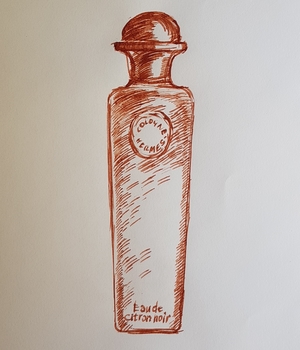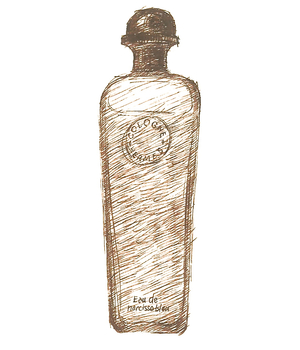Tagged With ‘sour’
Hermès
Eau de Citron Noir
2 July, 2018
 I’ve always loved eau de cologne. There’s nothing like the exhilarating zing of citrus to start your day, especially in sultry weather. The classic cologne such as 4711 Kölnisch Wasser, with its mix of citrus fruits, lavender, rosemary and neroli oil, is a well-nigh perfect (if all-too-evanescent) formulation, but over the years many perfumers have tried their hand at adding their own individual twist, with greater or lesser success.
I’ve always loved eau de cologne. There’s nothing like the exhilarating zing of citrus to start your day, especially in sultry weather. The classic cologne such as 4711 Kölnisch Wasser, with its mix of citrus fruits, lavender, rosemary and neroli oil, is a well-nigh perfect (if all-too-evanescent) formulation, but over the years many perfumers have tried their hand at adding their own individual twist, with greater or lesser success.
At Guerlain, for example, each generation of perfumers has created their own cologne, and the brand’s range of Les Eaux includes some wonderful reinterpretations such as Jacques Guerlain’s Eau de Fleurs de Cédrat from 1920, or current perfumer Thierry Wasser’s delicious Cologne de Parfumeur from 2010, which adds modern musks and a touch of cedar to the formula.
Hermès launched its first eau de cologne in 1979, with Françoise Caron’s superb Eau de Cologne d’Hermès, which was renamed Eau d’Orange Verte in 1997. For me it’s up there with Dior’s Eau Sauvage and Guerlain’s Vetiver as one of the greatest men’s perfumes around, and I’d expect that it remains their best-selling cologne. In 2009, though, Jean-Claude Ellena started expanding the range, with Eau de Gentiane Blanche and Eau de Pamplemousse Rose, followed in 2013 by Eau de Narcisse Bleue and Eau de Mandarine Ambrée.
Hermès released two more colognes in 2016, marking the handover between Jean-Claude Ellena and his successor as in-house perfumer, Christine Nagel. Ellena’s Eau de Neroli Dorée is a superb celebration of the scent of orange blossom, while Nagel’s Eau de Rhubarbe Ecarlate is fruity and great fun.
Her latest addition to the range is Eau de Citron Noir, which takes lime rather than lemon as its starting point. And not just any lime: the black lime of its name refers to the charcoal-black sun-dried limes you can buy in Oman, where they’re ground up and used as a spice. Nagel credits my fellow perfume blogger Persolaise for introducing her to this ingredient, which shows how important good blogs have become for the industry itself. Black limes give an earthy, rather sour taste to food, and lack the sweetness of fresh limes – but they also have a touch of smokiness, which Nagel has tried to recapture in her cologne.
As a fan of colognes in general and lime in particular, Citron Noir should be right up my street. And it is – at least to start with. As with most colognes, its initial, zesty burst of citrus quickly fades away, to be followed by Nagel’s recreation of the unusual fresh-but-smoky scent of black lime, which still (to me at least) has a bit of fruitiness about it. Unfortunately that’s where I get off, if I can put it that way: on my skin the fruitiness seems to turn slightly sour after a while, and that’s not what I’m looking for in a cologne. On the other hand it makes a fantastically invigorating shower gel, since its initial lime freshness has no time to disappear.
Hermès
Eau de Narcisse Bleu
10 October, 2014
 Pretty much everyone I know loves Hermès’ deliciously fresh and zingy Eau d’Orange Verte, so when Eau de Narcisse Bleu (literally ‘blue narcissus water’) was launched in 2013 it had a tough act to follow. As I’ve never seen a blue narcissus / daffodil, I think it’s safe to say that this perfume has an element of fantasy about it, and as a smell, too, it’s perhaps rather more complex and a little less instantly accessible than its predecessor. But give it a little time and I think it’ll grow on you.
Pretty much everyone I know loves Hermès’ deliciously fresh and zingy Eau d’Orange Verte, so when Eau de Narcisse Bleu (literally ‘blue narcissus water’) was launched in 2013 it had a tough act to follow. As I’ve never seen a blue narcissus / daffodil, I think it’s safe to say that this perfume has an element of fantasy about it, and as a smell, too, it’s perhaps rather more complex and a little less instantly accessible than its predecessor. But give it a little time and I think it’ll grow on you.
Eau de Narcisse Bleu may not have the euphoric mood-lifting freshness of Eau d’Orange Verte, but it has a gentle softness that, once you’ve smelled it for a while, is extremely appealing in its own right. It does have the faint sweetness of real daffodil flowers (try sticking your nose in one on a sunny day next March and you’ll see what I mean), but what narcissus extract smells of most, rather unexpectedly, is fresh hay. *
Now, I have nothing against smelling of hay, which is a lovely scent in its own right, but what Hermès’ much-mythologised perfumer, Jean-Claude Ellena, has done is blended the smell of hay with a whole raft of subtly complementary fragrances. Most of them are quite ‘green’ – that is, they smell fresh and natural, like grass and leaves, but not especially sweet or flower-like.
To me it has a slight but definite scent of fig-leaves, which for anyone who loves L’Artisan Parfumeur’s wonderful Premier Figuier as much as I do can only be a good thing. Whether this figginess is (excuse the pun) a figment of my imagination I’m not sure, but among the other ingredients that Ellena lists is galbanum, which is extracted from the root of a wild Iranian plant that looks a bit like fennel or cow-parsley, and indeed is distantly related to them.
Galbanum has a marvellously fresh sappy smell like newly-snapped pea-pods, and is one of the most important components of ‘green’ perfumes, but its greenness, here, is tempered by the hay-like sweetness of narcissus, with a hint of earthy bitterness underneath which manages to stop it from smelling at all girly.
If my description makes it sound a bit complicated, don’t be put off, for it’s such a well-blended perfume that there’s nothing discordant about it. In fact if anything it is, perhaps, a little too gentle for its own good, as it’s a ‘quiet’, thoughtful scent that stays close to your skin and doesn’t, on the whole, grab other people’s attention. It’s discreet and refined, in other words, rather than a ‘look-at-me’ perfume, which is perfect if you want to smell good without drawing attention to yourself. Go try it.
* I say ‘narcissus extract’, but one of the irritating things about perfume marketing is how vague – and frankly clueless – most descriptions of perfume ingredients actually are. For as anyone who actually grows the things themselves knows full well, a bright-yellow daffodil like Narcissus ‘February Gold’ smells very different to Narcissus papyraceus, the so-called paperwhite narcissus; the former has a gentle, hay-like scent, while one of the big selling-points of paperwhites is their powerful, almost jasmine-like perfume, the sweetness of which, en masse, can have a touch of the slightly repellent stagnant-water smell that perfumers refer to as ‘indolic’. If only perfume PRs were taught some basic botany.
Postscript – mystery solved, but only by going to the source: in France last week I visited IFF-LMR, the legendary natural raw perfume materials company near Grasse, and what should we get talking about but their narcissus extract, which is derived from the beautiful Narcissus poeticus, fields of which grow wild in the uplands of the Lozère. Did they use other species of daffodil as well? No, came the answer, and it’s their extract that you’re smelling (among many other things) in Eau de Narcisse Bleu.